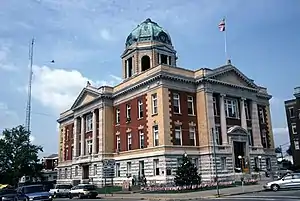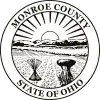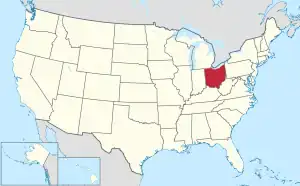Monroe County | |
|---|---|
 Monroe County Courthouse | |
 Seal | |
 Location within the U.S. state of Ohio | |
 Ohio's location within the U.S. | |
| Coordinates: 39°44′N 81°05′W / 39.73°N 81.08°W | |
| Country | |
| State | |
| Founded | March 1, 1815 |
| Named for | James Monroe |
| Seat | Woodsfield |
| Largest village | Woodsfield |
| Area | |
| • Total | 457 sq mi (1,180 km2) |
| • Land | 456 sq mi (1,180 km2) |
| • Water | 1.7 sq mi (4 km2) 0.4% |
| Population (2020) | |
| • Total | 13,385 |
| • Estimate (2021) | 13,329 |
| • Density | 29/sq mi (11/km2) |
| Time zone | UTC−5 (Eastern) |
| • Summer (DST) | UTC−4 (EDT) |
| Congressional district | 6th |
| Website | www |
Monroe County is a county located on the eastern border of the U.S. state of Ohio, across the Ohio River from West Virginia. As of the 2020 census, the population was 13,385,[1] making it the second-least populous county in Ohio. Its county seat is Woodsfield.[2] The county was created in 1813 and later organized in 1815.[3]
History
_(cropped2).jpg.webp)
Monroe County was formed on January 28, 1813, from portions of Belmont, Guernsey and Washington counties. It was named after James Monroe, the U.S. Secretary of State when the county was formed, and later fifth President of the United States.[4] When organized, the county's eastern border was with the state of Virginia. This portion of the state seceded from Virginia during the American Civil War, being admitted to the Union as the state of West Virginia. The largely rural county reached its peak of population in the 19th century, before urbanization drew people into and near cities for work and other opportunities. It is still a center of Amish population and farms.
In 1891, West Virginia's Sistersville Field was discovered to extend into Monroe County. By 1901, 300 wells near Woodsfield, Ohio, were producing 55,000 barrels of oil a month.[5]
On or about December 20, 2011, ExxonMobil, a New Jersey petroleum company, via its subsidiary XTO Energy, acquired 20,056 acres of Monroe County Utica Shale gas leases from Beck Energy.[6]
Geography
According to the United States Census Bureau, the county has a total area of 457 square miles (1,180 km2), of which 456 square miles (1,180 km2) is land and 1.7 square miles (4.4 km2) (0.4%) is water.[7] It is bordered by the Ohio River to the east. The terrain is hilly in this area, with waterways cutting through some hills of the Appalachian Plateau, which extends from Lake Erie to the Ohio River, which flows southwest to the south of this county.
Adjacent counties
- Belmont County (north)
- Marshall County, West Virginia (northeast)
- Wetzel County, West Virginia (east)
- Tyler County, West Virginia (southeast)
- Washington County (south)
- Noble County (west)
Major highways
National protected area
- Wayne National Forest (part)
Demographics
| Census | Pop. | Note | %± |
|---|---|---|---|
| 1820 | 4,645 | — | |
| 1830 | 8,768 | 88.8% | |
| 1840 | 18,521 | 111.2% | |
| 1850 | 28,351 | 53.1% | |
| 1860 | 25,741 | −9.2% | |
| 1870 | 25,779 | 0.1% | |
| 1880 | 26,496 | 2.8% | |
| 1890 | 25,175 | −5.0% | |
| 1900 | 27,031 | 7.4% | |
| 1910 | 24,244 | −10.3% | |
| 1920 | 20,660 | −14.8% | |
| 1930 | 18,426 | −10.8% | |
| 1940 | 18,641 | 1.2% | |
| 1950 | 15,362 | −17.6% | |
| 1960 | 15,268 | −0.6% | |
| 1970 | 15,739 | 3.1% | |
| 1980 | 17,382 | 10.4% | |
| 1990 | 15,497 | −10.8% | |
| 2000 | 15,180 | −2.0% | |
| 2010 | 14,642 | −3.5% | |
| 2020 | 13,385 | −8.6% | |
| 2021 (est.) | 13,329 | [8] | −0.4% |
| U.S. Decennial Census[9] 1790-1960[10] 1900-1990[11] 1990-2000[12] 2010-2020[13] | |||
2000 census
As of the census[14] of 2000, there were 15,180 people, 6,021 households, and 4,413 families living in the county. The population density was 33 people per square mile (13 people/km2). There were 7,212 housing units at an average density of 16 units per square mile (6.2/km2). The racial makeup of the county was 98.72% White, 0.26% Black or African American, 0.15% Native American, 0.07% Asian, 0.01% Pacific Islander, 0.11% from other races, and 0.67% from two or more races. 0.41% of the population were Hispanic or Latino of any race.
There were 6,021 households, out of which 29.50% had children under the age of 18 living with them, 61.70% were married couples living together, 8.10% had a female householder with no husband present, and 26.70% were non-families. 24.00% of all households were made up of individuals, and 11.50% had someone living alone who was 65 years of age or older. The average household size was 2.50 and the average family size was 2.96.
In the county, the population was spread out, with 23.60% under the age of 18, 7.10% from 18 to 24, 25.90% from 25 to 44, 27.20% from 45 to 64, and 16.30% who were 65 years of age or older. The median age was 41 years. For every 100 females there were 97.50 males. For every 100 females age 18 and over, there were 96.10 males.
The median income for a household in the county was $30,467, and the median income for a family was $36,297. Males had a median income of $33,308 versus $19,628 for females. The per capita income for the county was $15,096. About 11.00% of families and 13.90% of the population were below the poverty line, including 18.30% of those under age 18 and 11.40% of those age 65 or over.
2010 census
As of the 2010 United States Census, there were 14,642 people, 6,065 households, and 4,183 families living in the county.[15] The population density was 32.1 inhabitants per square mile (12.4/km2). There were 7,567 housing units at an average density of 16.6 units per square mile (6.4 units/km2).[16] The racial makeup of the county was 98.1% white, 0.4% black or African American, 0.1% Asian, 0.1% American Indian, 0.1% from other races, and 1.2% from two or more races. Those of Hispanic or Latino origin made up 0.4% of the population.[15] In terms of ancestry, 34.8% were German, 14.5% were Irish, 10.6% were English, and 9.6% were American.[17]
Of the 6,065 households, 27.3% had children under the age of 18 living with them, 56.0% were married couples living together, 8.6% had a female householder with no husband present, 31.0% were non-families, and 27.3% of all households were made up of individuals. The average household size was 2.39 and the average family size was 2.87. The median age was 44.7 years.[15]
The median income for a household in the county was $37,030 and the median income for a family was $43,261. Males had a median income of $39,261 versus $24,922 for females. The per capita income for the county was $18,738. About 12.3% of families and 17.3% of the population were below the poverty line, including 26.7% of those under age 18 and 12.3% of those age 65 or over.[18]
Politics

Mondale: 50–60% 60–70%
Reagan: 50–60%

Dukakis: 50–60% 60–70% 70–80%
Bush: 50–60%

Gore: 40–50% 50–60% 60–70%
Bush: 40–50% 50–60%

Kerry: 50–60% 60–70%
Bush: 50–60% 60–70%
Tie:

Obama: 40–50% 50–60% 60–70%
McCain: 40–50% 50–60%

Romney: 40–50% 50–60% 60–70%
Obama: 50–60%

Trump: 60–70% 70–80% 80–90%

Trump: 60–70% 70–80% 80–90%
As was typical for Appalachian counties, Monroe County voted Democratic in most elections – all but 7 times from 1856 until 2008. In 2012, it voted Republican for the first time since 1972. In 2016, it took a sharp turn to the right, voting for Donald Trump by a large margin. In the 2014 gubernatorial election, Monroe was one of two counties to vote for Democrat Ed FitzGerald over Republican John Kasich (along with Athens County). However, in 2018 it voted for Republican Mike DeWine over Democrat Richard Cordray.
| Year | Republican | Democratic | Third party | |||
|---|---|---|---|---|---|---|
| No. | % | No. | % | No. | % | |
| 2020 | 5,463 | 76.31% | 1,605 | 22.42% | 91 | 1.27% |
| 2016 | 4,868 | 71.03% | 1,662 | 24.25% | 323 | 4.71% |
| 2012 | 3,548 | 52.31% | 3,035 | 44.75% | 199 | 2.93% |
| 2008 | 3,066 | 43.91% | 3,705 | 53.07% | 211 | 3.02% |
| 2004 | 3,424 | 44.30% | 4,243 | 54.90% | 62 | 0.80% |
| 2000 | 3,145 | 44.20% | 3,605 | 50.67% | 365 | 5.13% |
| 1996 | 1,856 | 26.64% | 3,914 | 56.18% | 1,197 | 17.18% |
| 1992 | 1,823 | 24.02% | 4,235 | 55.79% | 1,533 | 20.19% |
| 1988 | 2,557 | 37.20% | 4,269 | 62.10% | 48 | 0.70% |
| 1984 | 3,302 | 47.32% | 3,611 | 51.75% | 65 | 0.93% |
| 1980 | 2,870 | 45.03% | 3,166 | 49.68% | 337 | 5.29% |
| 1976 | 2,728 | 38.25% | 4,296 | 60.24% | 108 | 1.51% |
| 1972 | 3,721 | 59.14% | 2,483 | 39.46% | 88 | 1.40% |
| 1968 | 2,686 | 42.27% | 3,105 | 48.87% | 563 | 8.86% |
| 1964 | 1,944 | 28.93% | 4,776 | 71.07% | 0 | 0.00% |
| 1960 | 4,106 | 56.63% | 3,144 | 43.37% | 0 | 0.00% |
| 1956 | 3,738 | 59.18% | 2,578 | 40.82% | 0 | 0.00% |
| 1952 | 3,493 | 52.09% | 3,213 | 47.91% | 0 | 0.00% |
| 1948 | 2,574 | 39.88% | 3,873 | 60.01% | 7 | 0.11% |
| 1944 | 3,617 | 50.30% | 3,574 | 49.70% | 0 | 0.00% |
| 1940 | 4,534 | 52.28% | 4,138 | 47.72% | 0 | 0.00% |
| 1936 | 3,211 | 36.87% | 5,368 | 61.64% | 130 | 1.49% |
| 1932 | 2,767 | 33.97% | 5,263 | 64.61% | 116 | 1.42% |
| 1928 | 4,287 | 60.73% | 2,729 | 38.66% | 43 | 0.61% |
| 1924 | 2,674 | 40.58% | 3,742 | 56.79% | 173 | 2.63% |
| 1920 | 2,825 | 41.94% | 3,861 | 57.32% | 50 | 0.74% |
| 1916 | 1,504 | 30.61% | 3,322 | 67.62% | 87 | 1.77% |
| 1912 | 1,055 | 21.79% | 3,199 | 66.08% | 587 | 12.13% |
| 1908 | 1,974 | 32.74% | 3,961 | 65.69% | 95 | 1.58% |
| 1904 | 2,222 | 40.17% | 3,169 | 57.30% | 140 | 2.53% |
| 1900 | 2,103 | 33.33% | 4,143 | 65.66% | 64 | 1.01% |
| 1896 | 2,001 | 32.07% | 4,180 | 67.00% | 58 | 0.93% |
| 1892 | 1,630 | 29.08% | 3,838 | 68.47% | 137 | 2.44% |
| 1888 | 1,621 | 29.04% | 3,886 | 69.63% | 74 | 1.33% |
| 1884 | 1,645 | 28.99% | 4,010 | 70.66% | 20 | 0.35% |
| 1880 | 1,600 | 29.30% | 3,751 | 68.70% | 109 | 2.00% |
| 1876 | 1,462 | 27.71% | 3,805 | 72.11% | 10 | 0.19% |
| 1872 | 1,307 | 30.74% | 2,878 | 67.69% | 67 | 1.58% |
| 1868 | 1,443 | 29.81% | 3,397 | 70.19% | 0 | 0.00% |
| 1864 | 1,440 | 31.03% | 3,201 | 68.97% | 0 | 0.00% |
| 1860 | 1,335 | 28.57% | 3,147 | 67.36% | 190 | 4.07% |
| 1856 | 1,016 | 23.96% | 2,812 | 66.31% | 413 | 9.74% |
Government
Monroe County has three County Commissioners who oversee the various County departments, similar to 85 of the other 88 Ohio counties. Current Commissioners are: Mick Schumacher (R), Bill Bolon (R), and Diane Burkhart (R).[20]
Monroe County is served by the Monroe County District Library from its administrative offices in Woodsfield, Ohio; it also offers a bookmobile service.
In 2005, the library loaned more than 141,000 items to its 6,000 cardholders. Total holding are over 64,000 volumes with over 140 periodical subscriptions.[21] This library is a member of the SOLO Regional Library System.
Education
Monroe County contains the following schools through the Switzerland of Ohio Local School District:
- Elementary Schools
- Beallsville Elementary School in Beallsville, Ohio
- River Elementary School in Hannibal, Ohio
- Skyvue Elementary School in Graysville, Ohio
- Woodsfield Elementary School in Woodsfield, Ohio
- St. Sylvester Central in Woodsfield, Ohio
- High Schools
- Monroe Central High School in Woodsfield, Ohio
- River High School in Hannibal, Ohio
- Beallsville High School in Beallsville, Ohio
- Career Center
- Swiss Hills Career Center in Woodsfield, Ohio
Communities

Villages
- Antioch
- Beallsville
- Clarington
- Graysville
- Jerusalem
- Lewisville
- Miltonsburg
- Stafford
- Wilson
- Woodsfield (county seat)
Townships
Census-designated places
Unincorporated communities
Ghost town
Notable people
- Philip Allen, member of the Wisconsin State Assembly[22]
- William C. Chynoweth, member of the Illinois House of Representatives[23]
- Sam V. Stewart, Montana Supreme Court Justice and the sixth Governor of Montana[24]
See also
References
- ↑ "U.S. Census Bureau QuickFacts: Hamilton County, Ohio". www.census.gov. United States Census Bureau. Retrieved June 26, 2022.
- ↑ "Find a County". National Association of Counties. Retrieved June 7, 2011.
- ↑ "Ohio: Individual County Chronologies". Ohio Atlas of Historical County Boundaries. The Newberry Library. 2007. Archived from the original on April 6, 2016. Retrieved February 14, 2015.
- ↑ "Monroe County data". Ohio State University Extension Data Center. Archived from the original on November 12, 2013. Retrieved April 28, 2007.
- ↑ Spencer, Jeff; Camp, Mark (2008). Ohio Oil and Gas (Images of America). Charleston: Arcadia Publishing. p. 9. ISBN 9780738551715.
- ↑ Correction: Exxon Buys 25K Acres of Utica Shale Leases in OH, Marcellus Drilling News
- ↑ "2010 Census Gazetteer Files". United States Census Bureau. August 22, 2012. Archived from the original on May 4, 2014. Retrieved February 9, 2015.
- ↑ "Annual Estimates of the Resident Population for Counties: April 1, 2020 to July 1, 2021". Retrieved June 26, 2022.
- ↑ "U.S. Decennial Census". United States Census Bureau. Retrieved February 9, 2015.
- ↑ "Historical Census Browser". University of Virginia Library. Retrieved February 9, 2015.
- ↑ Forstall, Richard L., ed. (March 27, 1995). "Population of Counties by Decennial Census: 1900 to 1990". United States Census Bureau. Retrieved February 9, 2015.
- ↑ "Census 2000 PHC-T-4. Ranking Tables for Counties: 1990 and 2000" (PDF). United States Census Bureau. April 2, 2001. Archived (PDF) from the original on March 27, 2010. Retrieved February 9, 2015.
- ↑ 2020 census
- ↑ "U.S. Census website". United States Census Bureau. Retrieved January 31, 2008.
- 1 2 3 "DP-1 Profile of General Population and Housing Characteristics: 2010 Demographic Profile Data". United States Census Bureau. Archived from the original on February 13, 2020. Retrieved December 27, 2015.
- ↑ "Population, Housing Units, Area, and Density: 2010 - County". United States Census Bureau. Archived from the original on February 13, 2020. Retrieved December 27, 2015.
- ↑ "DP02 SELECTED SOCIAL CHARACTERISTICS IN THE UNITED STATES – 2006-2010 American Community Survey 5-Year Estimates". United States Census Bureau. Archived from the original on February 13, 2020. Retrieved December 27, 2015.
- ↑ "DP03 SELECTED ECONOMIC CHARACTERISTICS – 2006-2010 American Community Survey 5-Year Estimates". United States Census Bureau. Archived from the original on February 13, 2020. Retrieved December 27, 2015.
- ↑ Leip, David. "Dave Leip's Atlas of U.S. Presidential Elections". uselectionatlas.org. Retrieved April 8, 2018.
- ↑ "Government-Monroe County Commissioners". Monroe County Ohio Homepage. Retrieved May 6, 2021.
- ↑ "2005 Ohio Public Library Statistics:Statistics by County and Town". State Library of Ohio. Archived from the original on September 24, 2006. Retrieved October 3, 2006.
- ↑ THE BLUE BOOK OF THE STATE OF WISCONSIN. 1889. p. 508.
- ↑ 'Illinois Blue Book 1933-1934,' Biographical Sketch of W. C. Chynoweth, pg. 170-171
- ↑ "Montana Governor Samuel Vernon Stewart". National Governors Association. Retrieved October 10, 2012.
Further reading
- Thomas William Lewis, History of Southeastern Ohio and the Muskingum Valley, 1788-1928. In Three Volumes. Chicago: S.J. Clarke Publishing Co., 1928.